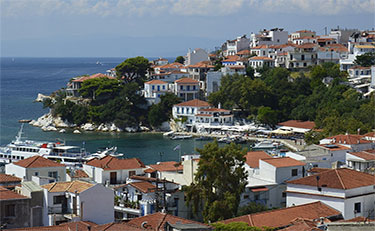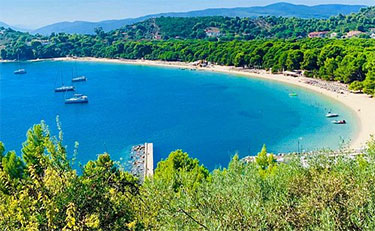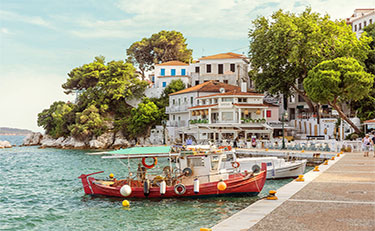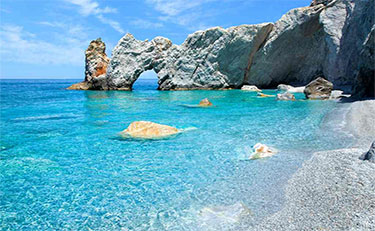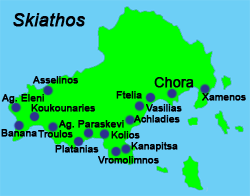|
Skiathos Island
Skiathos, the most western island of the Sporades Complex is a mountainous island with thick forests, rich waters and beautiful coasts. Skiathos covers an area of 61 km2 and has a coastline of 44 km. It has beautiful forests of pine and oak, rich waters and two nice little lakes. It has beautiful beaches, rockier in the north, larger and sandier in the south. One of the attraction of its coasts is the Blue Cave, on its northern side, which can be visited by boat. Kanapitsa, not very far from the capital, has rich greenery and beautiful bays. Koukounaries at the south, the most famous beach of Skiathos, is a wonderful place for swimming. The principal products of the island are olive oil and fruit. The waters of Skiathos are rich in fish and the inhabitants have been traditionally fishermen, but, in recent years, their principal occupation is tourism.
The architecture of Skiathos has not lost its character. The white houses of the island have roofs of tiles, few balconies and small flower gardens. Neoclassical buildings and old mansions adorn the capital. The new constructions for tourist accommodations are built following the traditions of the local architecture.
History The island was inhabited from Prehistoric times. In 480 BC, it was conquered by the Persians. In 476 BC, Skiathos was an ally of Athens and later of Sparta. It was conquered by Macedonia and by Rome. From the 4th Century AD, the island belonged to the Byzantine Empire and passed into the hands of Venice in 1204 AD. In 1538, it was conquered by the Turks and the inhabitants took refuge in the mountains, in the village of Kastro, which became the capital of the island during the fight against the Turks. In 1829 the island, finally free from the Turkish domination, became part of Greece.
Places of interest Kastro, the medieval refuge of the inhabitants from the Turks, is a reminder of its history, untouched by the time. Papadiamantis house. Skiathos is the birthplace of the great modern writer Papadiamantis, who lived there and today his house is a museum with his personal objects. The Monastery of Evanghelistria (1704), in the north of the island, with post-Byzantine icons, frescos and manuscripts. The Monastery of Kounistra (17th Century), in the center of the island, with the miracle-making icon of the Virgin Mary. The Monastery of Kehrias (1540), on the western side of the island. The Monastery of Agios Charalambos, near the capital. The Monastery of Agios Ioannis (1726), near the capital, with beautiful frescos.
Transportation By air Regular -40 minute- flights from Athens (El. Venizelos airport). (Olympic Airlines +30 210 9666666) By boat From Volos (41 n.m) by ferries in 3 hour or by hydrofoils in 1 hour 15 minutes. From Ag. Konstantinos (44 n.m) by ferries in 3 hour or by hydrofoils in 1 hour 20 minutes. Buses from the station of Suburban Buses, 100 Kifissou str., Athens run daily to the port of Agios Konstantinos (almost 3 hours).
|
